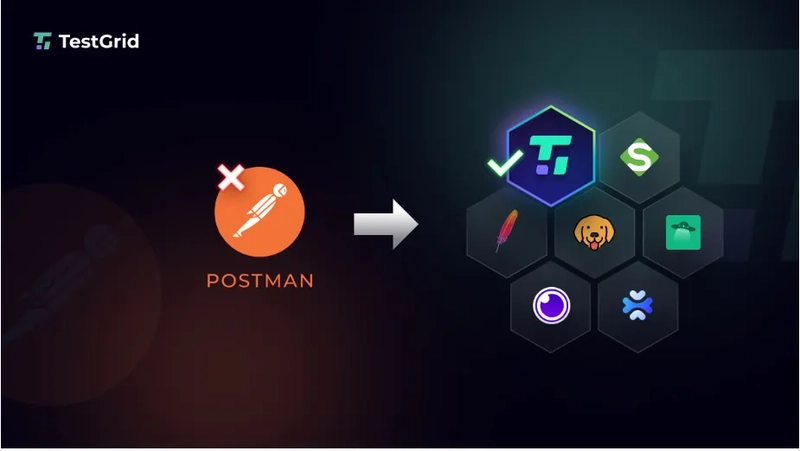The Best Postman Alternatives to Streamline API testing
Postman is an API platform for prototyping, documenting, and testing APIs in one single place. Its developer-friendly interface and comprehensive features make it a go-to tool for various businesses and teams. Postman supports various authentication types, enables on-demand testing with minimal setup, and works well with platforms like SAP CAP and SAP Build Process Automation. Despite such advantages, it isn’t free of drawbacks. For instance, the learning curve for advanced features, such as scripting in pre-request sections, can be steep, especially for solo developers or smaller teams. It can slow down or crash when handling extensive collections of datasets. Postman consumes significant CPU and RAM as a desktop app, affecting overall system performance. Its data management and manipulation tools are limited, making it difficult to execute complex test scenarios. Plus, Postman doesn’t have offline functionality. The good news is that plenty of alternative solutions offer faster performance, better integrations, or just a more straightforward experience. All you need to do is find the right tool for your work. In this blog, we’ll discuss 15 Postman alternatives, their features, pros and cons, and pricing. 1 Best Postman Alternatives in 2025 1. TestGrid TestGrid is an AI-powered end-to-end testing platform for web and mobile apps. It offers a secure and scalable test infrastructure for testing on real mobile devices and browsers through cloud services or on-premises setups. TestGrid supports API testing, positioning itself as a dynamic Postman alternative for those looking to integrate automated testing into their CI/CD pipelines. Before running GUI tests, validating the app’s code-level functionality through API and backend testing is essential. This helps catch subtle issues early in the development cycle, reducing the chances of critical failures during UI testing. The approach is beneficial if you work with an offshore QA team to test your API. TestGrid allows you to test on actual remote devices, browsers, operating systems, and versions — ensuring high accuracy and consistency across test runs. With quick alerts and faster debugging, you can prevent errors before they reach production, minimizing the Mean Time to Resolution (MTTR). One of TestGrid’s standout features is CoTester, the world’s first AI agent for software testing. It’s pre-trained on SLDC and advanced software testing fundamentals and uses true AI to understand user intent without rigid syntax constraints. It creates detailed test case descriptions and comes with a step-by-step editor for automated workflows. TestGrid features Test native, web, and hybrid apps on 1,000+ iOS and Android devices Validate functionality across APIs, UIs, servers, and databases, leading to improved product quality Evaluate app performance across devices with varying battery life, network conditions, and responsiveness Detect even the most minor visual deviations in your app with visual testing — no need to add any external SDK Record actions, create test scripts and automate tests in minutes with the intuitive ‘record and playback’ feature Set up Xray integration in minutes and view real-time execution statuses, timestamps, and downloadable reports directly inside JIRA Access remote devices using the Remote Lite feature, which provides instant connectivity via QR code or URL — only secure SSO authentication is required Scroll and swipe on remote iOS device with fewer touch points; replace full-screen gestures with simple taps, making the testing process faster and less tedious Leverage the Screen Broadcasting Turbo Mode to allow smooth, responsive remote access to iOS devices, even across continents and under low-bandwidth conditions TestGrid pros It enables you to start testing instantly with a clean, intuitive interface that supports automation, performance tracking, and structured test case analysis It equips you to manage broader project tasks by logging bugs, assigning them to team members, taking sprint notes, and setting task reminders It preserves security and control with features such as SSO authentication, link expiration controls, and customizable access settings It’s perfect for testing content-heavy apps like those in gaming or media TestGrid cons Since the platform offers a rich set of powerful testing features, it takes a bit of time to explore fully; however, the detailed documentation makes the learning curve manageable and the test process enjoyable TestGrid pricing Freemium: $0 per month (200 minutes per 2 minute session) Manual Testing: $25 per month (5 users, 1 parallel test) End-to-End Automation: $99 per month (5 users, 1 parallel test) Private Dedicated: Starts from $30 per month (5 users, 1 dedicated device) Enterprise (On-premise/Hosted): Custom pricing 2. SoapUI SoapUI is an open-source web service testing tool for Simple Object Access Protocol (SOAP) and representational state transfers. I

Postman is an API platform for prototyping, documenting, and testing APIs in one single place. Its developer-friendly interface and comprehensive features make it a go-to tool for various businesses and teams.
Postman supports various authentication types, enables on-demand testing with minimal setup, and works well with platforms like SAP CAP and SAP Build Process Automation. Despite such advantages, it isn’t free of drawbacks.
For instance, the learning curve for advanced features, such as scripting in pre-request sections, can be steep, especially for solo developers or smaller teams. It can slow down or crash when handling extensive collections of datasets.
Postman consumes significant CPU and RAM as a desktop app, affecting overall system performance. Its data management and manipulation tools are limited, making it difficult to execute complex test scenarios. Plus, Postman doesn’t have offline functionality.
The good news is that plenty of alternative solutions offer faster performance, better integrations, or just a more straightforward experience.
All you need to do is find the right tool for your work. In this blog, we’ll discuss 15 Postman alternatives, their features, pros and cons, and pricing.
1 Best Postman Alternatives in 2025
1. TestGrid
TestGrid is an AI-powered end-to-end testing platform for web and mobile apps. It offers a secure and scalable test infrastructure for testing on real mobile devices and browsers through cloud services or on-premises setups.
TestGrid supports API testing, positioning itself as a dynamic Postman alternative for those looking to integrate automated testing into their CI/CD pipelines. Before running GUI tests, validating the app’s code-level functionality through API and backend testing is essential.
This helps catch subtle issues early in the development cycle, reducing the chances of critical failures during UI testing. The approach is beneficial if you work with an offshore QA team to test your API.
TestGrid allows you to test on actual remote devices, browsers, operating systems, and versions — ensuring high accuracy and consistency across test runs.
With quick alerts and faster debugging, you can prevent errors before they reach production, minimizing the Mean Time to Resolution (MTTR). One of TestGrid’s standout features is CoTester, the world’s first AI agent for software testing.
It’s pre-trained on SLDC and advanced software testing fundamentals and uses true AI to understand user intent without rigid syntax constraints. It creates detailed test case descriptions and comes with a step-by-step editor for automated workflows.
TestGrid features
- Test native, web, and hybrid apps on 1,000+ iOS and Android devices
- Validate functionality across APIs, UIs, servers, and databases, leading to improved product quality
- Evaluate app performance across devices with varying battery life, network conditions, and responsiveness
- Detect even the most minor visual deviations in your app with visual testing — no need to add any external SDK
- Record actions, create test scripts and automate tests in minutes with the intuitive ‘record and playback’ feature
- Set up Xray integration in minutes and view real-time execution statuses, timestamps, and downloadable reports directly inside JIRA
- Access remote devices using the Remote Lite feature, which provides instant connectivity via QR code or URL — only secure SSO authentication is required
- Scroll and swipe on remote iOS device with fewer touch points; replace full-screen gestures with simple taps, making the testing process faster and less tedious
- Leverage the Screen Broadcasting Turbo Mode to allow smooth, responsive remote access to iOS devices, even across continents and under low-bandwidth conditions
TestGrid pros
- It enables you to start testing instantly with a clean, intuitive interface that supports automation, performance tracking, and structured test case analysis
- It equips you to manage broader project tasks by logging bugs, assigning them to team members, taking sprint notes, and setting task reminders
- It preserves security and control with features such as SSO authentication, link expiration controls, and customizable access settings
- It’s perfect for testing content-heavy apps like those in gaming or media
TestGrid cons
- Since the platform offers a rich set of powerful testing features, it takes a bit of time to explore fully; however, the detailed documentation makes the learning curve manageable and the test process enjoyable
TestGrid pricing
- Freemium: $0 per month (200 minutes per 2 minute session)
- Manual Testing: $25 per month (5 users, 1 parallel test)
- End-to-End Automation: $99 per month (5 users, 1 parallel test)
- Private Dedicated: Starts from $30 per month (5 users, 1 dedicated device)
- Enterprise (On-premise/Hosted): Custom pricing
2. SoapUI
SoapUI is an open-source web service testing tool for Simple Object Access Protocol (SOAP) and representational state transfers. Its functionality covers web service inspection, development, simulation, mocking, load, and compliance testing. It’s particularly well-suited for complex enterprise environments that rely on legacy systems.
SoapUI features
- Create and run even the most complex scenarios with its drag-and-drop test creation
- Mimic your real web services without having to wait for them to be accessible or ready
- Perform load testing quickly and easily based on existing functional API tests
SoapUI pros
- There’s no need to build expensive full-scale replicas of your production
- It has a vibrant community and partner ecosystem, which fosters continuous innovation and learning
- SoapUI cons
- Setting up and configuring the tool is intimidating for beginners
- As test suites grow in complexity, maintaining and updating test cases can be labor-intensive
SoapUI pricing
- Free to use, as it’s open-source
3. Apache JMeter
Apache JMeter is a 100% pure Java app designed to load test functional behavior and measure performance. It can simulate a heavy load on a server, group of servers, network, or object. It has a full-featured test IDE that allows fast test plan recording (from browsers or native apps), building, and debugging.
Apache JMeter features
- Perform load and performance tests for different apps, servers, and protocol types, including FTP, LDAP, TCP, and Java Objects
- Extract data from the most popular response formats, such as JSON, HTML, and XML, for easy correlation
- Save test results in various formats; analyze and replay them even when offline
Apache JMeter pros
- It offers complete portability and 100% Java purity
- It integrates with third-party open-source libraries for Jenkins, Gradle, and Maven
Apache JMeter cons
- Although JMeter looks like a browser, it isn’t and doesn’t perform all the actions supported by browsers
- It can indeed run out of memory when simulating high loads or using inefficient configurations
Apache JMeter pricing
- Free to use, as it’s open-source
4. Bruno
Bruno is a Postman alternative focused on testing local-first, file-based API collections. Developers who prefer version control and lightweight approaches will find this a handy tool. It’s fast and Git-friendly. Bruno is also known for its simple offline-only design.
Bruno features
- Use a plain text markup language called Bru to save information about API requests
- Store all your API collections (as text files) and configurations directly on your machine
- Can be installed via Homebrew, Chocolatey, Scoop, Snap, Flatpak, Apt, and Winget
Bruno pros
- It’s available in multiple languages, including English, German, Korean, Arabic, and Russian
- It does not require heavy memory usage or background processes
Bruno cons
- You can’t collaborate in real time unless you manually use Git to share collections
- It’s limited to REST APIs at the moment and doesn’t support GraphQL, WebSockets, and gRPC
Bruno pricing
- Free to use, as it’s open-sourc
5. Hoppscotch
Hoppscotch is a web-based API development suite. It was built with accessibility in mind, providing all the functionality needed for API developers with a minimalist and unobtrusive UI. This Postman alternative equips you to modify headers, authenticate requests, generate random data, and more.
Hoppscotch features
- Use the CLI to run your requests from the terminal; automate your workflow
- Generate code snippets for your requests in various languages and frameworks
- Handle different types of communication protocols beyond just standard HTTP requests, including GraphQL, Socket.io, and MQTT
Hoppscotch pros
- It’s built with performance in mind and is fast and reliable
- It allows you to track all the activities in your workspace
Hoppscotch cons
- Because of its focus on simplicity, it’s not apt for advanced testing scenarios
- Its documentation may not be as extensive or detailed compared to other Postman alternatives
Hoppscotch pricing
- Free: $0 per month
- Organization: $8 per month/user, billed monthly
6. cURL
cURL is a CLI tool and library perfect for scripting API requests and test automation. It supports a range of protocols, including FTP, SFTP, HTTP, HTTPS, and more. It helps developers and system administrators make API requests and inspect responses directly from the command line.
cURL features
- Minimize bandwidth usage by enabling data compression using formats such as gzip or deflate
- Fetch data from a URL (e.g., downloading web pages or files) or submit data (e.g., sending form data or interacting with APIs)
- Anonymize your IP, bypass geo-restrictions, or test how your apps perform in different locations by routing requests through a proxy server
cURL pros
Getting help to use the tool properly isn’t a hassle; you can hire any skilled engineer to fix your cURL-related problems
Its source code is easily compiled and built on almost any operating system and platform
cURL cons
- It’s targeted at single-shot file transfers and isn’t a wget clone
- It’s not an FTP site mirroring program, which means you’ll have to write a script for automated, systematic, and sequential FTP transfers
cURL pricing
- Free to use, as it’s open-source
7. Assertible
Assertible is a Postman alternative built for automated assertions, API health checks, and deployment testing. It provides a reliable first line of defense against web service failures, lowering the number of false positives in your automated QA tests and websites.
Assertible features
Automatically sync your API tests with the latest changes in your specifications; add and update responses, headers, parameters, and so on
Set up scheduled monitoring to continuously test your services and customize how you’re alerted about failures
Create domain-specific tests using its powerful and robust HTTP assertions
Assertible pros
- It allows you to run your API tests against any environment, like staging or production
- It supports modern DevOps workflows like CI/CD pipelines
Assertible cons
- It demands a stronger understanding of API concepts and testing methodologies
- Scaling API testing with a large number of APIs and tests can become complex and potentially costly
Assertible pricing
- Personal: $0 per month (10 tests per service)
- Standard: $25 per month (500 tests per service)
- Startup: $50 per month (500 tests per service)
- Business: $100 per month (1,000 tests per service)
Conclusion
While Postman remains a popular choice for API testing, it’s not without its limitations — especially when it comes to performance, scalability, and offline access. Fortunately, there are several powerful alternatives available in 2025, each catering to different needs, teams, and workflows. Whether you’re looking for AI-powered automation with TestGrid, open-source flexibility with SoapUI and JMeter, or lightweight local-first tools like Bruno, the right API testing solution is out there. Choose the one that best aligns with your project goals and technical stack.
Source: This blog was originally published at Testgrid











































































































































































![[The AI Show Episode 142]: ChatGPT’s New Image Generator, Studio Ghibli Craze and Backlash, Gemini 2.5, OpenAI Academy, 4o Updates, Vibe Marketing & xAI Acquires X](https://www.marketingaiinstitute.com/hubfs/ep%20142%20cover.png)




























































































































![[DEALS] The Premium Learn to Code Certification Bundle (97% off) & Other Deals Up To 98% Off – Offers End Soon!](https://www.javacodegeeks.com/wp-content/uploads/2012/12/jcg-logo.jpg)


![From drop-out to software architect with Jason Lengstorf [Podcast #167]](https://cdn.hashnode.com/res/hashnode/image/upload/v1743796461357/f3d19cd7-e6f5-4d7c-8bfc-eb974bc8da68.png?#)








































































































.png?#)

































_Christophe_Coat_Alamy.jpg?#)
 (1).webp?#)





































































































![Apple Considers Delaying Smart Home Hub Until 2026 [Gurman]](https://www.iclarified.com/images/news/96946/96946/96946-640.jpg)
![iPhone 17 Pro Won't Feature Two-Toned Back [Gurman]](https://www.iclarified.com/images/news/96944/96944/96944-640.jpg)
![Tariffs Threaten Apple's $999 iPhone Price Point in the U.S. [Gurman]](https://www.iclarified.com/images/news/96943/96943/96943-640.jpg)




































































































































